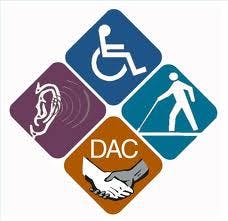Employment laws can be confusing and downright scary.
They don’t have to be. As a public service, from now until my special Halloween webinar Answers to the World’s Scariest Employment Law Questions, I’ll be tackling each major law one by one to give you what you REALLY need to know. By the end, you’ll have handy one-page cheat sheets for each and every law and your terror level will be reduced to zero.
Whenever we survey our visitors and webinar participants on which law scares ‘em the most, the Americans with Disabilities Act (ADA) is always near the top. Add on top of that the new Americans with Disabilities Amendments Act (ADAAA) and you have a real recipe for discombobulation.
Here is basically everything you need to know about the ADA and ADAAA in one handy post.
ADA & ADAAA cheat sheet
What employers are covered?
Those with 15 or more employees.
What employees are eligible?
Persons:
- With a physical or mental impairment that substantially limits one or more major life activities;
- With a record of such an impairment; and,
- Regarded as having such an impairment.
What’s prohibited?
- Discrimination against individuals with (or perceived to have) disabilities;
- Discrimination based on a person’s relationship to a disabled individual; and,
- Retaliation or harassment for exercising ADA rights.
What’s required?
Employers must provide a reasonable accommodation to a disabled individual upon request.
What’s a “reasonable accommodation?”
A modification that allows the person to perform the job’s essential functions but doesn’t cause “undue hardship” for the employer.
What did the ADAAA add?
Disabilities are easier to prove. The ADAAA overturned several Supreme Court decisions that Congress felt interpreted “disability” too narrowly and expressly states that it should be interpreted in favor of broad coverage.
New rules of the ADA road. The ADAAA adopted “rules of construction” for determining when an individual is “substantially limited in performing a major life activity.” They are:
- “Substantially limits” is construed broadly and requires a lower degree of functional limitation than the previous standard.
- Individual assessments are required to determine whether a condition substantially limits a major life activity.
- Mitigating measures such as medication or hearing aids can’t be considered, with the exception of glasses and contact lenses.
- Episodic or remission conditions constitute disabilities if they substantially limit a major life activity.
Several conditions “virtually always constitute a disability.” The ADAAA provides examples of conditions that “should easily be concluded to be disabilities,” including bipolar disorder, cancer, diabetes, epilepsy and HIV infection.
Stay tuned for more. Tomorrow we’ll de-scare-ify the Age Discrimination in Employment Act (ADEA).
This was originally published on Manpower Group’s Employment Blawg.
